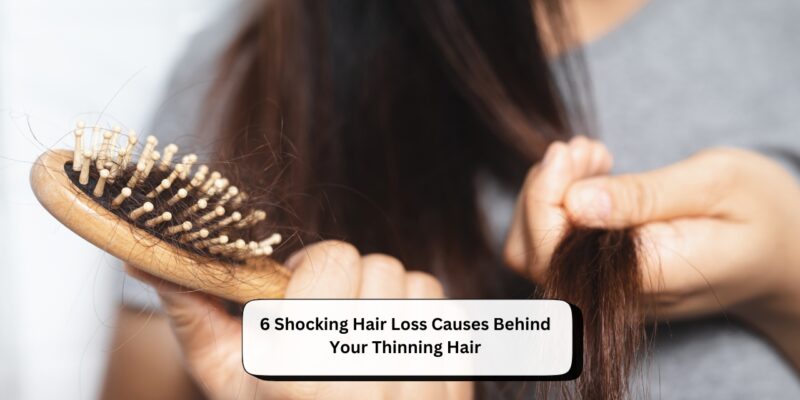6 Shocking Hair Loss Causes Behind Your Thinning Hair
Hair loss is a common concern for both men and women across the globe. Whether it’s shedding a few strands or noticing noticeable bald patches, understanding the causes behind hair thinning can be a game changer. If you’re struggling with thinning hair, don’t worry—you’re not alone! In this blog, we’ll dive deep into the Hair Loss Causes and explore what’s really behind your thinning hair. We’ll also look at some effective treatments and solutions to restore your hair health. Let’s get started!
1. Causes of Hair Loss in Men
When it comes to Hair Loss in Men, the most common culprit is male pattern baldness or androgenetic alopecia. It’s a genetic condition that affects most men as they age, usually starting in their late 20s to early 30s. Male pattern baldness typically begins with a receding hairline or thinning at the crown, eventually leading to significant bald patches.
But it’s not just genetics at play here. Stress, poor diet, and hormonal changes can also contribute to hair loss. Many men also suffer from telogen effluvium, a condition where hair prematurely enters the resting phase due to stress, illness, or even poor nutrition.
If you’re facing Hair Loss in Men, iGraft offers a range of hair restoration treatments that can help you regain your confidence and hair health. Check out their Hair Transplant Solutions for more details on customized treatment options.
2. Causes of Hair Loss in Women
While male pattern baldness is the most recognized form of hair loss in men, Hair Loss in Women can happen for a variety of reasons. Women are more likely to experience hair thinning across the entire scalp, rather than bald patches. One of the most significant causes of hair loss in women is hormonal imbalances. Pregnancy, menopause, and conditions like polycystic ovary syndrome (PCOS) can disrupt hormone levels, leading to thinning hair.
Another common cause is postpartum hair loss. After giving birth, many women experience excessive shedding for several months due to hormonal changes. This can be a stressful time, as the body is adjusting to post-pregnancy changes, including fluctuating hormones.
Telogen effluvium is also a significant factor in female hair loss. This condition is often triggered by stress or a sudden physical change, like a crash diet or illness. The good news? It’s usually temporary, and hair can grow back with the right care.
For women struggling with Hair Loss Causes, iGraft provides solutions like hair transplants and non-surgical treatments designed for women. Find out more about their Female Hair Restoration Options here.
3. Stress and Hair Loss: A Silent Contributor
Stress plays a significant role in Hair Loss Causes, and it’s not just something we can brush off. In fact, emotional stress and trauma can trigger telogen effluvium, which leads to hair shedding. This happens when a large number of hair follicles go into the resting phase prematurely, causing hair to fall out in clumps.
Moreover, stress may exacerbate other underlying conditions like male pattern baldness or female hair thinning, making the situation worse. If you are experiencing stress-related hair loss, relaxation techniques, exercise, and a healthy diet can significantly help. Taking the time to manage your stress levels can ultimately reduce the impact on your hair.
If stress is a major factor in your hair loss, check out iGraft’s comprehensive Hair Loss Solutions that include not only transplants but also holistic treatments designed to improve overall scalp health.
4. Diet and Nutritional Deficiencies: Your Hair’s Silent Enemy
A poor diet is one of the most overlooked causes of hair loss. Nutritional deficiencies—especially a lack of iron, vitamin D, zinc, and biotin—can impact the growth of healthy hair. When your body isn’t getting the nutrients it needs, it can push hair follicles into the resting phase, which results in shedding.
Hair Growth Vitamins and supplements can help bridge this gap, providing essential nutrients for hair restoration. Eating a balanced diet rich in vitamins, minerals, and protein is crucial for preventing Hair Loss Causes related to poor nutrition.
If you’re struggling with thinning hair due to dietary reasons, consider speaking with a healthcare professional to address any deficiencies.
5. Hormonal Imbalances and Hair Loss
Hormonal imbalances are a key factor in both Hair Loss in Women and Hair Loss in Men. As mentioned earlier, women experience hormonal shifts during pregnancy, menopause, and with conditions like PCOS. These changes can cause hair to thin, fall out, or grow more slowly. For men, changes in testosterone levels can lead to male pattern baldness.
Other factors contributing to hormonal hair loss include thyroid problems and the use of hormonal birth control. It’s essential to understand the specific hormonal cause of your hair loss so that you can choose the best treatment.
For more information on Hair Loss Treatment, including hormonal therapies, check out iGraft’s Hair Restoration Options that can cater to your specific needs.
6. Aging and Hair Loss
As we age, the natural growth cycle of our hair begins to slow down. Hair follicles shrink over time, which leads to thinner, shorter hair. This is a natural part of the aging process, and both men and women can experience it. While it’s not entirely preventable, certain treatments can slow the process and even encourage hair regrowth.
Hair restoration treatments like FUE hair transplants or PRP therapy can help rejuvenate aging hair follicles and improve the overall density of your hair. If aging is the primary cause of your hair thinning, these advanced treatments might be exactly what you need to restore your youthful appearance.
Conclusion: Understanding Hair Loss Causes and Finding Solutions
Understanding the underlying Hair Loss Causes is the first step in taking control of your hair health. Whether it’s genetics, hormonal imbalances, stress, or nutritional deficiencies, there are plenty of options available to treat and manage your hair loss effectively.
Remember, hair restoration is a journey, and finding the right solution depends on your unique needs. If you’re struggling with thinning hair, iGraft offers personalized solutions ranging from hair transplants to non-surgical treatments designed to suit your lifestyle and goals.
For more information, visit iGraft Global Hair Services. Take the first step toward healthier, fuller hair today!










